Non-vascular plants are plants without a vascular system consisting of xylem and phloem. Although non-vascular plants lack these particular tissues, many possess simpler tissues that are specialized for internal transport of water.
Non-vascular plants do not have a wide variety of specialized tissue types. Mosses and leafy liverworts have structures that look like leaves, but are not true leaves because they are single sheets of cells with no stomata, no internal air spaces and have no xylem or phloem. Consequently, they are unable to control the rate of water loss from their tissues and are said to be poikilohydric. These organisms do, however, have an elementary cuticle which was important in the evolution of land plants.
All land plants have a life cycle with an alternation of generations between a diploid sporophyte and a haploid gametophyte, but in all non-vascular land plants the gametophyte generation is dominant. In these plants, the sporophytes grow from and are dependent on gametophytes for taking in water and mineral nutrients and for provision of photosynthate, the products of photosynthesis.
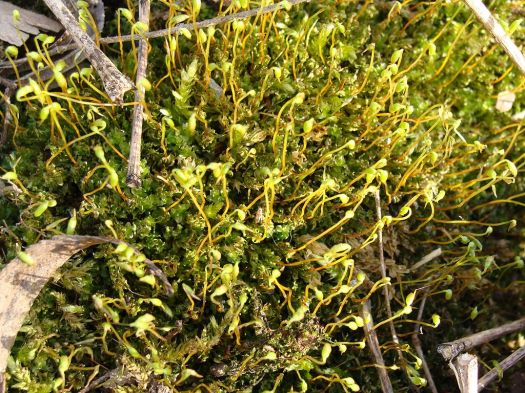
Non-vascular plants include two distantly related groups:
- Bryophytes, an informal group that is now treated as three separate land plant Divisions, namely Bryophyta (mosses), Marchantiophyta (liverworts), and Anthocerotophyta(hornworts). In all bryophytes, the primary plants are the haploid gametophytes, with the only diploid portion being the attached sporophyte, consisting of a stalk and sporangium. Because these plants lack lignified water-conducting tissues, they can’t become as tall as most vascular plants.
- Algae – especially the green algae. Recent studies have demonstrated that the algae consist of several unrelated groups. It turns out that the common features of living in water and photosynthesis were misleading as indicators of close relationship. Only those groups of algae included in the Viridiplantae are still considered relatives of land plants.
These groups are sometimes referred to as “lower plants”, referring to their status as the earliest plant groups to evolve, but the usage is imprecise, since both groups are polyphyletic and may be used to include vascularcryptogams, such as the ferns and fern allies that reproduce using spores. Non-vascular plants are often among the first species to move into new and inhospitable territories, along with prokaryotes and protists, and thus function as pioneer species.
Bryphotes
Bryophytes are an informal group consisting of three divisions of non-vascular land plants (embryophytes), the liverworts, hornworts and mosses. They are characteristically limited in size and prefer moist habitats although they can survive in drier environments. The bryophytes consist of about 20,000 plant species. Bryophytes produce enclosed reproductive structures (gametangia and sporangia), but they do not produce flowers or seeds. They reproduce via spores. Bryophytes are usually considered to be a paraphyleticgroup and not a monophyletic group, although some studies have produced contrary results. Regardless of their status, the name is convenient and remains in use as an informal collective term. The term “bryophyte” comes from Greek βρύον, bryon “tree-moss, oyster-green” and φυτόν, phyton “plant”.
The defining features of bryophytes are:
- Their life cycles are dominated by the gametophyte stage
- Their sporophytes are unbranched
- They do not have a true vascular tissue containing lignin (although some have specialized tissues for the transport of water)
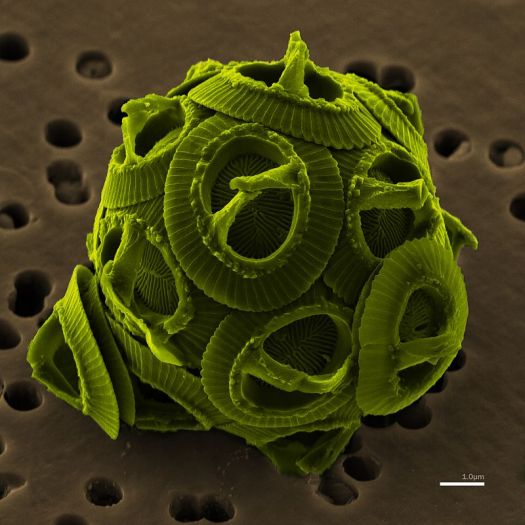
Classification and phylogeny
Traditionally, all living land plants without vascular tissues were classified in a single taxonomic group, often a division (or phylum). More recently, phylogenetic research has questioned whether the bryophytes form a monophyletic group and thus whether they should form a single taxon. Although a 2005 study supported the traditional view that the bryophytes form a monophyletic group, by 2010 a broad consensus had emerged among systematists that bryophytes as a whole are not a natural group (i.e., are paraphyletic), although each of the three extant (living) groups is monophyletic.
The three bryophyte clades are the Divisions Marchantiophyta (liverworts), Bryophyta (mosses) and Anthocerotophyta (hornworts). The vascular plants or tracheophytes form a fourth, unranked clade of land plants called the “Polysporangiophyta“. In this analysis, hornworts are sister to vascular plants and liverworts are sister to all other land plants, including the hornworts and mosses. Phylogenetic studies continue to produce conflicting results. In particular those based on gene sequences suggest the bryophytes are paraphyletic, whereas those based on the amino acid translations of the same genes suggest they are monophyletic. A 2014 study concluded that composition biases were responsible for these differences and that the bryophytes are monophyletic. The issue remains unresolved.
When extinct plants are taken into account, the picture is slightly altered. Some extinct land plants, such as the horneophytes, are not bryophytes, but also are not vascular plants because, like bryophytes, they do not have true vascular tissue. A different distinction is needed. In bryophytes, the sporophyte is a simple unbranched structure with a single spore-forming organ (sporangium). In all other land plants, the polysporangiophytes, the sporophyte is branched and carries many sporangia. It has been argued that this contrast between bryophytes and other land plants is less misleading than the traditional one of non-vascular versus vascular plant, since many mosses have well-developed water-conducting vessels.
The term “bryophyte” thus refers to a grade of lineages defined primarily by what they lack. Compared to other living land plants, they lack vascular tissue containing lignin and branched sporophytes bearing multiple sporangia. The prominence of the gametophyte in the life cycle is also a shared feature of the three bryophyte lineages (extant vascular plants are all sporophyte dominant).
Algae

Algae (/ˈældʒi, ˈælɡi/; singular alga /ˈælɡə/) is an informal term for a large, diverse group of photosynthetic organisms that are not necessarily closely related, and is thus polyphyletic. Included organisms range from unicellular microalgae genera, such as Chlorella and the diatoms, to multicellular forms, such as the giant kelp, a large brown alga which may grow up to 50 m in length. Most are aquatic and autotrophic and lack many of the distinct cell and tissue types, such as stomata, xylem, and phloem, which are found in land plants. The largest and most complex marine algae are called seaweeds, while the most complex freshwater forms are the Charophyta, a division of green algae which includes, for example, Spirogyra and the stoneworts.
No definition of algae is generally accepted. One definition is that algae “have chlorophyll as their primary photosynthetic pigment and lack a sterile covering of cells around their reproductive cells”. Some authors exclude all prokaryotes and thus do not consider cyanobacteria (blue-green algae) as algae.
Algae constitute a polyphyletic group since they do not include a common ancestor, and although their plastids seem to have a single origin, from cyanobacteria, they were acquired in different ways. Green algae are examples of algae that have primary chloroplasts derived from endosymbiotic cyanobacteria. Diatoms and brown algae are examples of algae with secondary chloroplasts derived from an endosymbiotic red alga.
Algae exhibit a wide range of reproductive strategies, from simple asexual cell division to complex forms of sexual reproduction.
Algae lack the various structures that characterize land plants, such as the phyllids (leaf-like structures) of bryophytes, rhizoids in nonvascular plants, and the roots, leaves, and other organs found in tracheophytes (vascular plants). Most are phototrophic, although some are mixotrophic, deriving energy both from photosynthesis and uptake of organic carbon either by osmotrophy, myzotrophy, or phagotrophy. Some unicellular species of green algae, many golden algae, euglenids, dinoflagellates, and other algae have become heterotrophs (also called colorless or apochlorotic algae), sometimes parasitic, relying entirely on external energy sources and have limited or no photosynthetic apparatus.[8][9][10] Some other heterotrophic organisms, such as the apicomplexans, are also derived from cells whose ancestors possessed plastids, but are not traditionally considered as algae. Algae have photosynthetic machinery ultimately derived from cyanobacteria that produce oxygen as a by-product of photosynthesis, unlike other photosynthetic bacteria such as purple and green sulfur bacteria. Fossilized filamentous algae from the Vindhya basin have been dated back to 1.6 to 1.7 billion years ago.
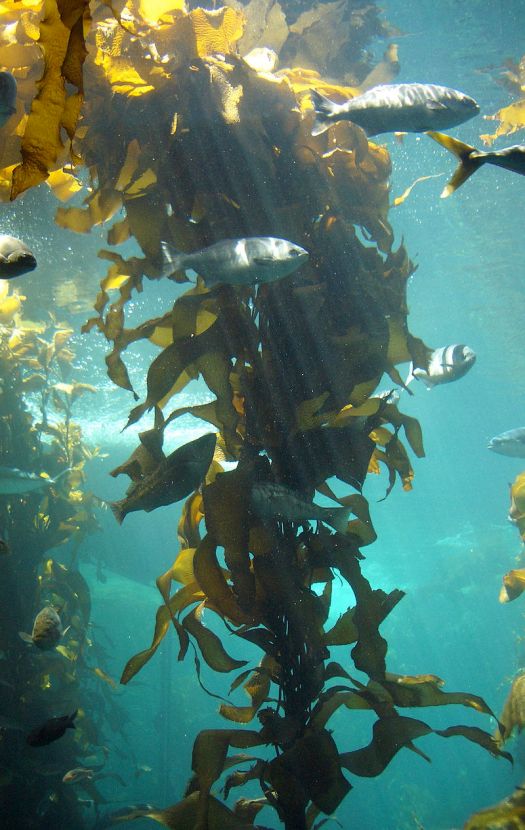
Etymology and study
The singular alga is the Latin word for “seaweed” and retains that meaning in English. The etymology is obscure. Although some speculate that it is related to Latin algēre, “be cold”, no reason is known to associate seaweed with temperature. A more likely source is alliga, “binding, entwining”.
The Ancient Greek word for seaweed was φῦκος (phŷcos), which could mean either the seaweed (probably red algae) or a red dye derived from it. The Latinization, fūcus, meant primarily the cosmetic rouge. The etymology is uncertain, but a strong candidate has long been some word related to the Biblical פוך (pūk), “paint” (if not that word itself), a cosmetic eye-shadow used by the ancient Egyptians and other inhabitants of the eastern Mediterranean. It could be any color: black, red, green, or blue.
Accordingly, the modern study of marine and freshwater algae is called either phycology or algology, depending on whether the Greek or Latin root is used. The name Fucus appears in a number of taxa.
Classification
Most algae contain chloroplasts that are similar in structure to cyanobacteria. Chloroplasts contain circular DNA like that in cyanobacteria and presumably represent reduced endosymbiotic cyanobacteria. However, the exact origin of the chloroplasts is different among separate lineages of algae, reflecting their acquisition during different endosymbiotic events. The table below describes the composition of the three major groups of algae. Their lineage relationships are shown in the figure in the upper right. Many of these groups contain some members that are no longer photosynthetic. Some retain plastids, but not chloroplasts, while others have lost plastids entirely.
Title page of Gmelin’sHistoria Fucorum, dated 1768
Linnaeus, in Species Plantarum (1753), the starting point for modern botanical nomenclature, recognized 14 genera of algae, of which only four are currently considered among algae. In Systema Naturae, Linnaeus described the genera Volvox and Corallina, and a species of Acetabularia (as Madrepora), among the animals.
In 1768, Samuel Gottlieb Gmelin (1744–1774) published the Historia Fucorum, the first work dedicated to marine algae and the first book on marine biology to use the then new binomial nomenclature of Linnaeus. It included elaborate illustrations of seaweed and marine algae on folded leaves.
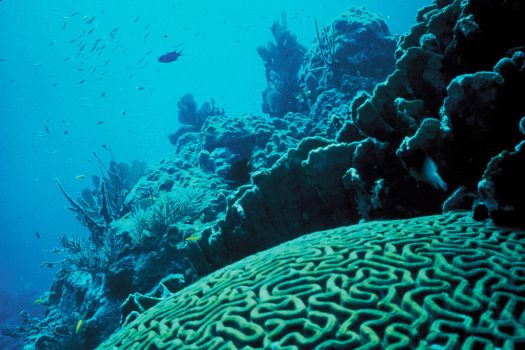
W.H.Harvey (1811—1866) and Lamouroux (1813) were the first to divide macroscopic algae into four divisions based on their pigmentation. This is the first use of a biochemical criterion in plant systematics. Harvey’s four divisions are: red algae (Rhodospermae), brown algae (Melanospermae), green algae (Chlorospermae), and Diatomaceae.
At this time, microscopic algae were discovered and reported by a different group of workers (e.g., O. F. Müller and Ehrenberg) studying the Infusoria (microscopic organisms). Unlike macroalgae, which were clearly viewed as plants, microalgae were frequently considered animals because they are often motile. Even the nonmotile (coccoid) microalgae were sometimes merely seen as stages of the lifecycle of plants, macroalgae, or animals.
Although used as a taxonomic category in some pre-Darwinian classifications, e.g., Linnaeus (1753), de Jussieu (1789), Horaninow (1843), Agassiz (1859), Wilson & Cassin (1864), in further classifications, the “algae” are seen as an artificial, polyphyletic group.
Throughout the 20th century, most classifications treated the following groups as divisions or classes of algae: cyanophytes, rhodophytes, chrysophytes, xanthophytes, bacillariophytes, phaeophytes, pyrrhophytes (cryptophytes and dinophytes), euglenophytes, and chlorophytes. Later, many new groups were discovered (e.g., Bolidophyceae), and others were splintered from older groups: charophytes and glaucophytes (from chlorophytes), many heterokontophytes (e.g., synurophytes from chrysophytes, or eustigmatophytes from xanthophytes), haptophytes (from chrysophytes), and chlorarachniophytes (from xanthophytes).
With the abandonment of plant-animal dichotomous classification, most groups of algae (sometimes all) were included in Protista, later also abandoned in favour of Eukaryota. However, as a legacy of the older plant life scheme, some groups that were also treated as protozoans in the past still have duplicated classifications (see ambiregnal protists).
Some parasitic algae (e.g., the green algae Prototheca and Helicosporidium, parasites of metazoans, or Cephaleuros, parasites of plants) were originally classified as fungi, sporozoans, or protistans of incertae sedis, while others (e.g., the green algae Phyllosiphon and Rhodochytrium, parasites of plants, or the red algae Pterocladiophila and Gelidiocolax mammillatus, parasites of other red algae, or the dinoflagellates Oodinium, parasites of fish) had their relationship with algae conjectured early. In other cases, some groups were originally characterized as parasitic algae (e.g., Chlorochytrium), but later were seen as endophytic algae. Some filamentous bacteria (e.g., Beggiatoa) were originally seen as algae. Furthermore, groups like the apicomplexans are also parasites derived from ancestors that possessed plastids, but are not included in any group traditionally seen as algae.
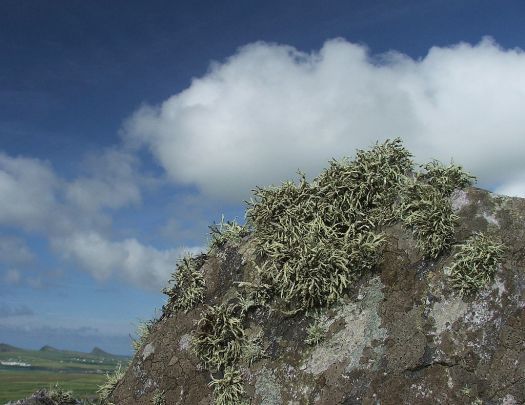
Morphology
A range of algal morphologies is exhibited, and convergence of features in unrelated groups is common. The only groups to exhibit three-dimensional multicellular thalli are the reds and browns, and some chlorophytes. Apical growth is constrained to subsets of these groups: the florideophyte reds, various browns, and the charophytes. The form of charophytes is quite different from those of reds and browns, because they have distinct nodes, separated by internode ‘stems’; whorls of branches reminiscent of the horsetails occur at the nodes. Conceptacles are another polyphyletic trait; they appear in the coralline algae and the Hildenbrandiales, as well as the browns.
Most of the simpler algae are unicellular flagellates or amoeboids, but colonial and nonmotile forms have developed independently among several of the groups. Some of the more common organizational levels, more than one of which may occur in the lifecycle of a species, are
- Colonial: small, regular groups of motile cells
- Capsoid: individual non-motile cells embedded in mucilage
- Coccoid: individual non-motile cells with cell walls
- Palmelloid: nonmotile cells embedded in mucilage
- Filamentous: a string of nonmotile cells connected together, sometimes branching
- Parenchymatous: cells forming a thallus with partial differentiation of tissues
In three lines, even higher levels of organization have been reached, with full tissue differentiation. These are the brown algae,some of which may reach 50 m in length (kelps) the red algae, and the green algae. The most complex forms are found among the green algae (see Charales and Charophyta), in a lineage that eventually led to the higher land plants. The point where these nonalgal plants begin and algae stop is usually taken to be the presence of reproductive organs with protective cell layers, a characteristic not found in the other algal groups.
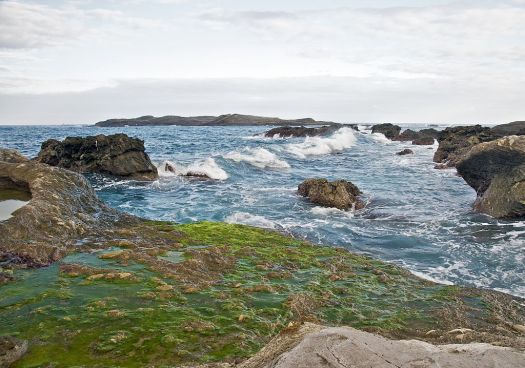
Physiology
Many algae, particularly members of the Characeae, have served as model experimental organisms to understand the mechanisms of the water permeability of membranes, osmoregulation, turgor regulation, salt tolerance, cytoplasmic streaming, and the generation of action potentials.
Phytohormones are found not only in higher plants, but in algae, too.
Symbiotic algae
Some species of algae form symbiotic relationships with other organisms. In these symbioses, the algae supply photosynthates (organic substances) to the host organism providing protection to the algal cells. The host organism derives some or all of its energy requirements from the algae. Examples are:
Lichens
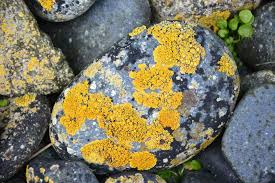
Lichens are defined by the International Association for Lichenology to be “an association of a fungus and a photosynthetic symbiont resulting in a stable vegetative body having a specific structure.” The fungi, or mycobionts, are mainly from the Ascomycota with a few from the Basidiomycota. They are not found alone in nature; but when they began to associate is not known. One mycobiont associates with the same phycobiont species, rarely two, from the green algae, except that alternatively, the mycobiont may associate with a species of cyanobacteria (hence “photobiont” is the more accurate term). A photobiont may be associated with many different mycobionts or may live independently; accordingly, lichens are named and classified as fungal species. The association is termed a morphogenesis because the lichen has a form and capabilities not possessed by the symbiont species alone (they can be experimentally isolated). The photobiont possibly triggers otherwise latent genes in the mycobiont.
Coral reefs

Coral reefs are accumulated from the calcareous exoskeletons of marine invertebrates of the order Scleractinia (stony corals). These animals metabolize sugar and oxygen to obtain energy for their cell-building processes, including secretion of the exoskeleton, with water and carbon dioxide as byproducts. Dinoflagellates (algal protists) are often endosymbionts in the cells of the coral-forming marine invertebrates, where they accelerate host-cell metabolism by generating immediately available sugar and oxygen through photosynthesis using incident light and the carbon dioxide produced by the host. Reef-building stony corals (hermatypic corals) require endosymbiotic algae from the genus Symbiodinium to be in a healthy condition.[47] The loss of Symbiodinium from the host is known as coral bleaching, a condition which leads to the deterioration of a reef.
Sea sponges
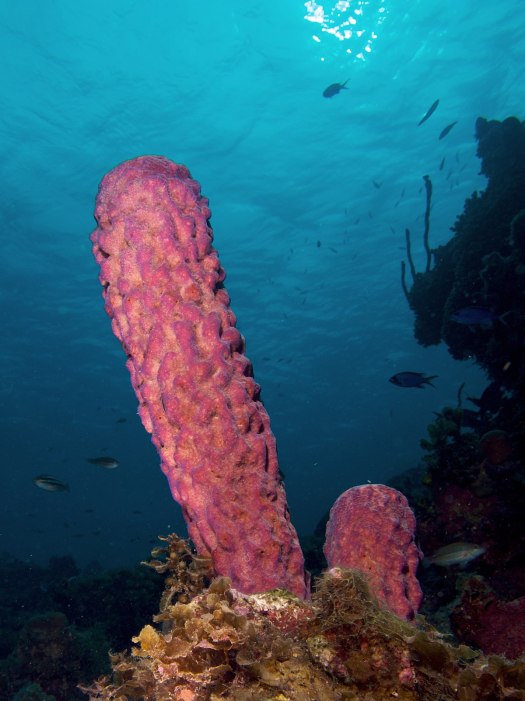
Green algae live close to the surface of some sponges, for example, breadcrumb sponge (Halichondria panicea). The alga is thus protected from predators; the sponge is provided with oxygen and sugars which can account for 50 to 80% of sponge growth in some species.

